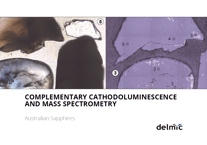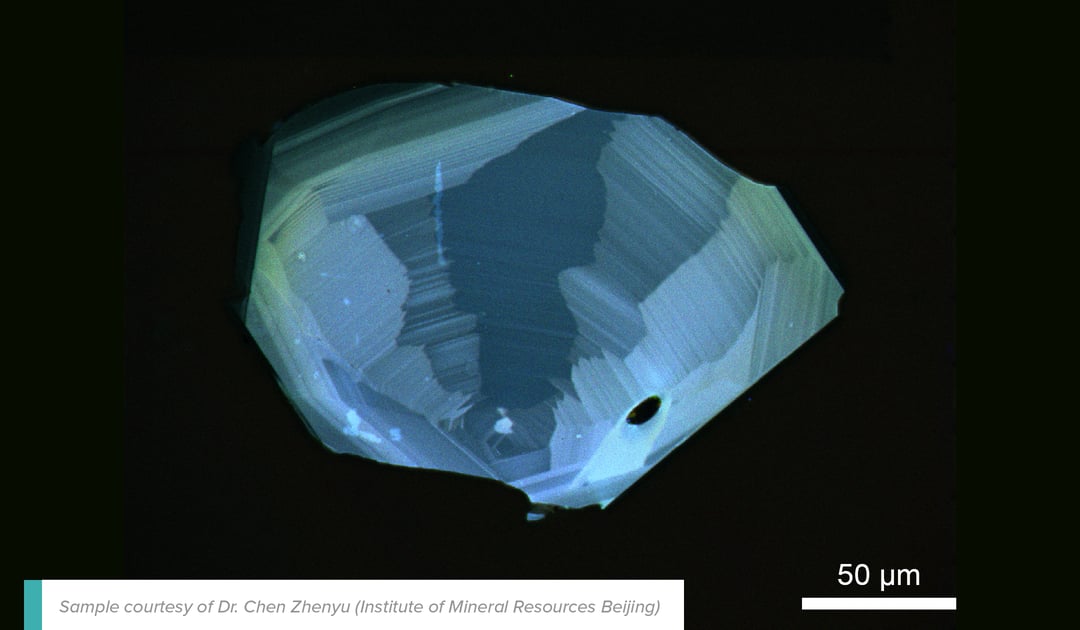Cathodoluminescence (CL) is a very useful method of data acquisition in geosciences as it reveals information not readily provided by other techniques.
The excitation of electrons in the sample that produces the light seen through a cathodoluminescence system occurs in specific chemical impurities or intrinsic defects within a geological structure.
Integrated with a scanning electron microscope [2], cathodoluminescence allows the scientists to visualize sites that are damaged by radiation or deformation, or sites that have a different chemical composition or crystal structure for example. Some studies of the texture of a particular geological sample can be linked to particular geological events using CL [1]. CL is thus not only important for understanding the composition of various materials in a site, but also the changes that have occurred over time.
CL reveals an explosion of color when used on geological samples, which provides clues as to the composition of a sample. For instance, zircons emit a whole range of hues depending on their refractive indices and thus their composition. In 1885, Becquerel found that different materials emit different colors: calcite luminesces orange, quartz yellow, and aragonite green. Further studies have found that with CL rubies glow red, emeralds are crimson red, sapphires are blueish gray, and cassiterite is pale yellow [2]. In the study of quartz, blue luminescence can point to a high titanium content [1].
It is in combination with a scanning electron microscope (SEM) that the benefits of CL can most effectively be reaped in geosciences. In such a system, the functional information obtained from the optical response generated by the electron beam is combined with the extremely high spatial resolution associated with an electron microscope.
The power of cathodoluminescence in geosciences is being more and more frequently applied for studying various geological samples such as minerals (zircon), sedimentary rocks (quartz) and precious gemstones (sapphire). Zircons in particular are frequently studied using a SEM cathodoluminescence system. This mineral is extremely resistant to weathering processes and can be found in a wide variety of rocks. Changes in the chemical composition of rocks over time lead to zonations in the zircon, in which different zones of zircon have varying chemical compositions. Comparable to rings in trees, the study of zircons can open up a breadth of information on historical changes in the rock. In fact, the oldest native crustal rock from earth ever to be dated was done so by observing zircons through a combined SEM CL system and quantitative isotope analysis in a mass spectrometer [3] (to learn more about the application of CL for the study of zircons, see this application note).
Cathodoluminescence spectroscopy can also be applied to study the properties of sedimentary rocks. Quartz sandstones, common example of sedimentary rocks, is one of the main sources of fossil fuels (oil, natural gas, coal), thus it holds a practical value. Using CL imaging it is possible to map the quartz composition of the sample which enables, for instance, the rigorous segmentation of granular material and cemented material. By combining these results with other SEM techniques, the geological history as well as the porosity of the rock can be studied in great detail (to learn more about studying sedimentary rocks, read this white paper).
While imaging zircons and sedimentary rocks with cathodoluminescence is becoming more common, the natural sapphires are being rarely examined with CL. One of the recent researches prove, however, that cathodoluminescence allows to assess crystallisation histories of this precious gemstone, underlying causes for luminescence and examine color zonation, which is a common feature in natural sapphires that may document potential changes in growth environments. To read how Alluvial sapphires from eastern Australia were analysed by cathodoluminescence download the new white paper below:

Download white paper:
Complementary cathodoluminescence and mass spectroscopy of Australian Sapphires
References
[1] McLemore, Virginia T, and James M. Barker. "Some geological applications of cathodoluminescence."
[2] Pagel, Maurice, et al., eds. Cathodoluminescence in geosciences. Springer Science & Business Media, 2013.
[3] S. A. Wilde et al., Nature 409 (2001) 175-178.
.png)






